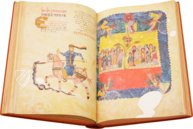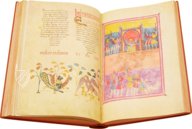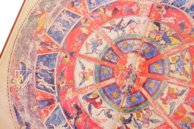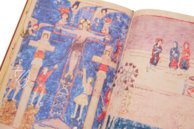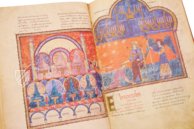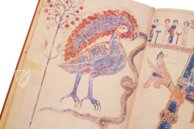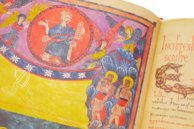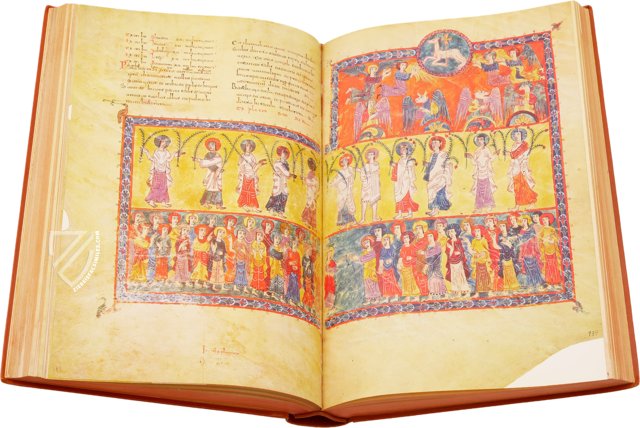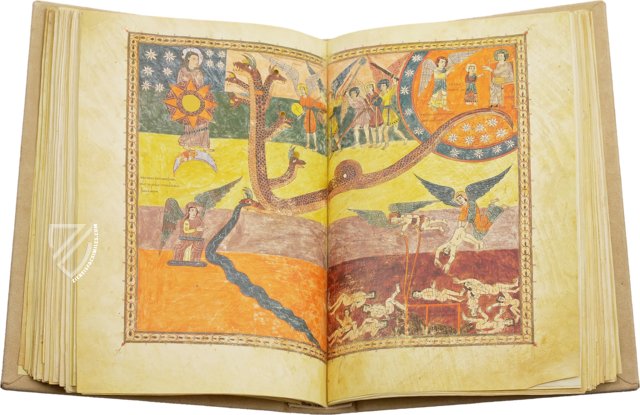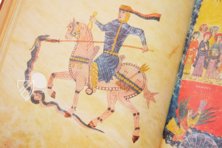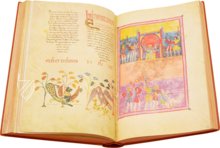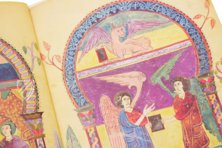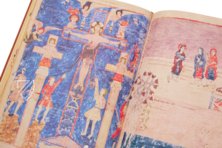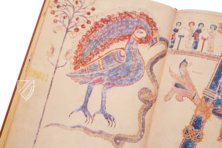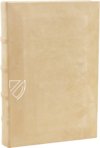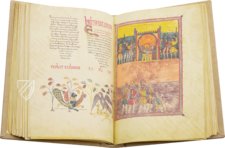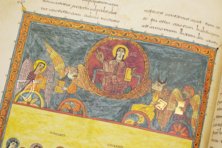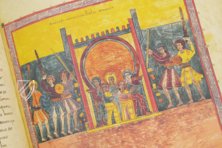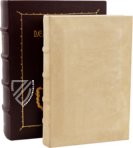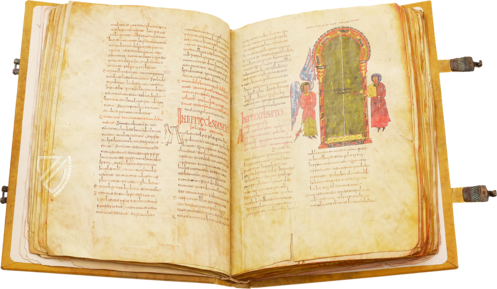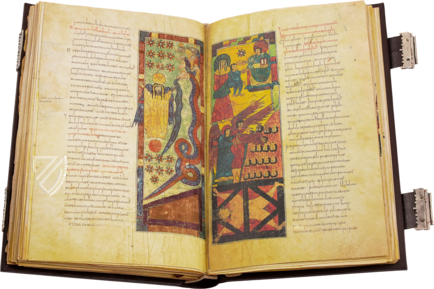Beatus of Liébana - Girona Codex
(1,000€ - 3,000€)
The Girona Codex from the series of Beatus-manuscripts is the most attractively decorated and best documented work of the apocalypse manuscripts by Beatus de Liébana, giving us precious insights into the origins of the codex and of contemporary manuscript production in general. Created ca. 975 by and for members of the Spanish clergy, it contains 124 high-quality miniatures in subdued colors and costly adornments of gold and silver, including a double-page miniature of heaven in six concentric circles. Named after its repository in the treasury of Girona Cathedral, this beautifully illuminated manuscript is one of the most important and informative works of the Beatus tradition.
Beatus of Liébana - Girona Codex
Beatus de Liébana was a monk and theologian who belonged to the Monastery of Santo Toribio de Liébana in modern Spain. The monk is known above all else for this main work, a commentary on the biblical Apocalypse in twelve books. The Girona Codex is one of these books. It is an especially interesting and striking fragment of the twelve-part series of books. The manuscript arose in the second half of the 10th century and contains 124 miniatures richly embellished with gold and silver in all.
A Successful Collaboration
Alongside Beatus, the author of the Girona Codex, other involved person were also named. In doing so, the master of the work easily identified something that was rarely the case with Romanesque codices. Even the date of its origin was noted. The document originated ca. 975 at the behest of Abbot Dominicus. As illuminators, the nun En and the monk Emterius were named. The meticulous script of the text was completed by the scribe Senior. The gifted collective produced one of the most elegant and artful codices from the series of Beatus-Apocalypses.
The Finest Illumination
The valuable manuscript begins with a series of miniatures, which are to be found in no other Beatus-codex. A two-page depiction of heaven in six concentric circles opens the work. Hereupon follows a cycle of six full-page miniatures about the life of Christ, in which, among others, scenes of the crucifixion and descent into hell are depicted. The full-page, framed miniatures show astonishingly diverse and fantastical representations. The colors of the pictures appear subdued and unagitated. Numerous miniatures are adorned with gold and silver. The valuable original edition of the manuscript is housed today in the Girona Cathedral in Spain.
Codicology
- Alternative Titles
- Girona Beatus
Beatus of Gerona
Beato de Liébana, códice del Monasterio de San Salvador de Tábara, Zamora
Beatus von Girona
Beato di Girona
Béatus de Gérone - Size / Format
- 568 pages / 40.0 × 26.0 cm
- Origin
- Spain
- Date
- 975
- Epochs
- Style
- Genre
- Language
- Script
- Visigothic minuscule
- Illustrations
- 124 illuminations decorated with gold and silver
- Patron
- Abbot Dominicus
- Artist / School
- Beatus of Liébana (died after 798) (author)
Emerterius, monk (illuminator)
Ende, nun (illuminator)
Senior, monk (scribe)
Beatus of Liébana - Girona Codex
The Seven Bowls
“And out of the temple came the seven angels having the seven plagues, clothed in pure bright linen, and having their chests girded with golden bands. Then one of the four living creatures gave to the seven angels seven golden bowls full of the wrath of God who lives forever and ever.” (Rev. 15:6-7). Depicted here holding golden U-shaped objects representing bowls, seven barefooted angels in colorful robes prepare to unleash natural disasters upon the earth including turning the oceans to blood.
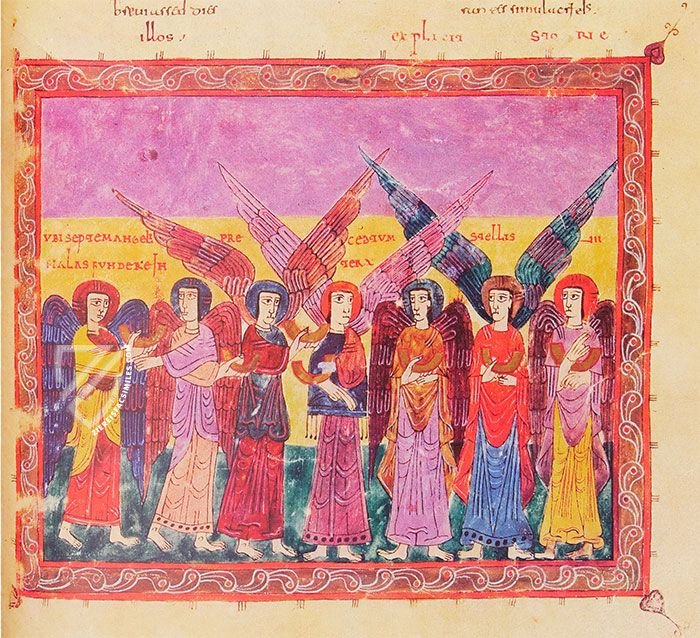
Beatus of Liébana - Girona Codex
The Metaphor of the Palm Tree
Begun while in Constantinople and completed in 595, the Moralia in lob is an extensive commentary on the Book of Job with many allegorical elements by Saint Gregory the Great. Gregory compares a saint’s life to a palm tree: the base is rough while the top is full of leafy branches and fruit just as the righteous path is difficult but leads to the rewards of Paradise.
The naked man climbing the tree with a pruning knife represents those seeking salvation while the clothed man represents religion, which supports the faithful in their ascensions to Glory. They can also be interpreted as representing the body and the soul, respectively. The palm tree thus represents Christ and his cross, which make it possible to harvest the fruit of salvation.
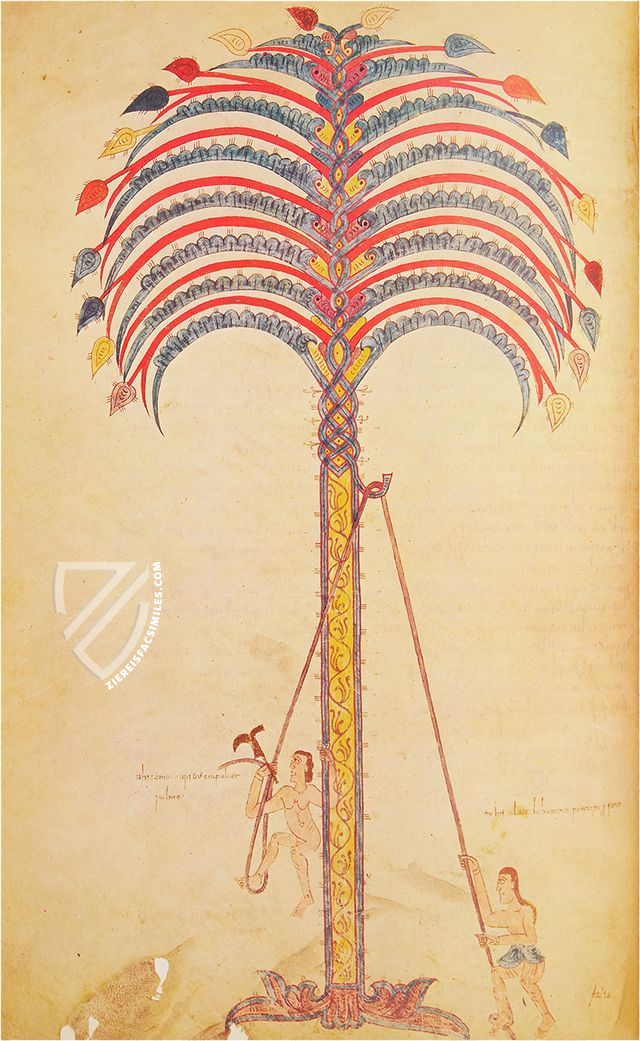
#1 Beato de Gerona
Language: Spanish
(1,000€ - 3,000€)
#2 Beato de Liébana, códice del Monasterio de San Salvador de Tábara, Zamora
Languages: English, Spanish
(3,000€ - 7,000€)
- Treatises / Secular Books
- Apocalypses / Beatus
- Astronomy / Astrology
- Bestiaries
- Bibles / Gospels
- Chronicles / History / Law
- Geography / Maps
- Saints' Lives
- Islam / Oriental
- Judaism / Hebrew
- Single Leaf Collections
- Leonardo da Vinci
- Literature / Poetry
- Liturgical Manuscripts
- Medicine / Botany / Alchemy
- Music
- Mythology / Prophecies
- Psalters
- Other Religious Books
- Games / Hunting
- Private Devotion Books
- Other Genres
- Afghanistan
- Armenia
- Austria
- Belgium
- Colombia
- Croatia
- Cyprus
- Czech Republic
- Denmark
- Egypt
- Ethiopia
- France
- Germany
- Greece
- Hungary
- India
- Iran
- Iraq
- Israel
- Italy
- Japan
- Lebanon
- Luxembourg
- Mexico
- Morocco
- Netherlands
- Palestine
- Peru
- Poland
- Portugal
- Russia
- Serbia
- Spain
- Sri Lanka
- Sweden
- Switzerland
- Syria
- Turkey
- Ukraine
- United Kingdom
- United States
- Uzbekistan
- Aboca Museum
- Ajuntament de Valencia
- Akademie Verlag
- Akademische Druck- u. Verlagsanstalt (ADEVA)
- Aldo Ausilio Editore - Bottega d’Erasmo
- Alecto Historical Editions
- Alkuin Verlag
- Almqvist & Wiksell
- Amilcare Pizzi
- Andreas & Andreas Verlagsbuchhandlung
- Archa 90
- Archiv Verlag
- Archivi Edizioni
- Arnold Verlag
- ARS
- Ars Magna
- ArtCodex
- AyN Ediciones
- Azimuth Editions
- Badenia Verlag
- Bärenreiter-Verlag
- Belser Verlag
- Belser Verlag / WK Wertkontor
- Benziger Verlag
- Bernardinum Wydawnictwo
- BiblioGemma
- Biblioteca Apostolica Vaticana (Vaticanstadt, Vaticanstadt)
- Bibliotheca Palatina Faksimile Verlag
- Bibliotheca Rara
- Boydell & Brewer
- Bramante Edizioni
- Bredius Genootschap
- Brepols Publishers
- British Library
- C. Weckesser
- Caixa Catalunya
- Canesi
- CAPSA, Ars Scriptoria
- Caratzas Brothers, Publishers
- Carus Verlag
- Casamassima Libri
- Chavane Verlag
- Christian Brandstätter Verlag
- Circulo Cientifico
- Club Bibliófilo Versol
- Club du Livre
- CM Editores
- Collegium Graphicum
- Collezione Apocrifa Da Vinci
- Comissão Nacional para as Comemorações dos Descobrimentos Portugueses
- Coron Verlag
- Corvina
- CTHS
- D. S. Brewer
- Damon
- De Agostini/UTET
- De Nederlandsche Boekhandel
- De Schutter
- Deuschle & Stemmle
- Deutscher Verlag für Kunstwissenschaft
- DIAMM
- Droz
- E. Schreiber Graphische Kunstanstalten
- Ediciones Boreal
- Ediciones Grial
- Ediclube
- Edições Inapa
- Edilan
- Editalia
- Edition Deuschle
- Edition Georg Popp
- Edition Leipzig
- Edition Libri Illustri
- Editiones Reales Sitios S. L.
- Éditions de l'Oiseau Lyre
- Editions Medicina Rara
- Editorial Casariego
- Editorial Mintzoa
- Editrice Antenore
- Editrice Velar
- Edizioni Edison
- Egeria, S.L.
- Eikon Editores
- Electa
- Emery Walker Limited
- Enciclopèdia Catalana
- Eos-Verlag
- Ephesus Publishing
- Ernst Battenberg
- Eugrammia Press
- Extraordinary Editions
- Fackelverlag
- Facsimila Art & Edition
- Facsimile Editions Ltd.
- Facsimilia Art & Edition Ebert KG
- Faksimile Verlag
- Feuermann Verlag
- Folger Shakespeare Library
- Franco Cosimo Panini Editore
- Friedrich Wittig Verlag
- Fundación Hullera Vasco-Leonesa
- G. Braziller
- Gabriele Mazzotta Editore
- Gebr. Mann Verlag
- Gesellschaft für graphische Industrie
- Getty Research Institute
- Giovanni Domenico de Rossi
- Giunti Editore
- Graffiti
- Grafica European Center of Fine Arts
- Guido Pressler
- Guillermo Blazquez
- Gustav Kiepenheuer
- H. N. Abrams
- Harrassowitz
- Helikon
- Hendrickson Publishers
- Henning Oppermann
- Herder Verlag
- Hes & De Graaf Publishers
- Hoepli
- Holbein-Verlag
- Hortus Deliciarum
- Houghton Library
- Hugo Schmidt Verlag
- Idion Verlag
- Il Bulino, edizioni d'arte
- ILte
- Imago
- Insel Verlag
- Instituto Nacional de Antropología e Historia
- Istituto dell'Enciclopedia Italiana - Treccani
- Istituto Ellenico di Studi Bizantini e Postbizantini
- Istituto Geografico De Agostini
- Istituto Poligrafico e Zecca dello Stato
- Italarte Art Establishments
- J. Thorbecke
- Jan Thorbecke Verlag
- Johnson Reprint Corporation
- Josef Stocker
- Josef Stocker-Schmid
- Jugoslavija
- Karl W. Hiersemann
- Kasper Straube
- Kaydeda Ediciones
- Kindler Verlag / Coron Verlag
- Kodansha International Ltd.
- Konrad Kölbl Verlag
- Kurt Wolff Verlag
- La Liberia dello Stato
- La Linea Editrice
- La Meta Editore
- Lambert Schneider
- Landeskreditbank Baden-Württemberg
- Leo S. Olschki
- Les Incunables
- Library of Congress
- Libreria Musicale Italiana
- Lichtdruck
- Lito Immagine Editore
- Lumen Artis
- Lund Humphries
- M. Moleiro Editor
- Maison des Sciences de l'homme et de la société de Poitiers
- Manuscriptum
- Martinus Nijhoff
- Maruzen-Yushodo Co. Ltd.
- MASA
- McGraw-Hill
- Militos
- Millennium Liber
- Müller & Schindler
- Nahar and Steimatzky
- National Library of Wales
- Neri Pozza
- Nova Charta
- Oceanum Verlag
- Odeon
- Orbis Mediaevalis
- Orbis Pictus
- Österreichische Staatsdruckerei
- Oxford University Press
- Pageant Books
- Parzellers Buchverlag
- Patrimonio Ediciones
- Pattloch Verlag
- PIAF
- Pieper Verlag
- Plon-Nourrit et cie
- Prestel Verlag
- Princeton University Press
- Prisma Verlag
- Priuli & Verlucca, editori
- Pro Sport Verlag
- Propyläen Verlag
- Pytheas Books
- Quaternio Verlag Luzern
- Reales Sitios
- Recht-Verlag
- Reichert Verlag
- Reichsdruckerei
- Riehn & Reusch
- Roberto Vattori Editore
- Rosenkilde and Bagger
- Roxburghe Club
- Salerno Editrice
- Sarajevo Svjetlost
- Schöck ArtPrint Kft.
- Scolar Press
- Scrinium
- Scripta Maneant
- Scriptorium
- Siloé, arte y bibliofilia
- SISMEL - Edizioni del Galluzzo
- Sociedad Mexicana de Antropología
- Société des Bibliophiles & Iconophiles de Belgique
- Soncin Publishing
- Sorli Ediciones
- Stainer and Bell
- Studer
- Styria Verlag
- Sumptibus Pragopress
- Szegedi Tudomànyegyetem
- Taberna Libraria
- Tarshish Books
- Taschen
- Tempus Libri
- Testimonio Compañía Editorial
- Thames and Hudson
- The Clear Vue Publishing Partnership Limited
- The Facsimile Codex
- The Folio Society
- The Marquess of Normanby
- The Richard III and Yorkist History Trust
- Tip.Le.Co
- TouchArt
- TREC Publishing House
- TRI Publishing Co.
- Trident Editore
- Typis Regiae Officinae Polygraphicae
- Union Verlag Berlin
- Universidad de Granada
- University of California Press
- University of Chicago Press
- Urs Graf
- Vallecchi
- Van Wijnen
- VCH, Acta Humaniora
- VDI Verlag
- VEB Deutscher Verlag für Musik
- Verlag Anton Pustet / Andreas Verlag
- Verlag Bibliophile Drucke Josef Stocker
- Verlag der Münchner Drucke
- Verlag für Regionalgeschichte
- Verlag Styria
- Vicent Garcia Editores
- W. Turnowsky
- Waanders Printers
- Wiener Mechitharisten-Congregation (Wien, Österreich)
- Wissenschaftliche Buchgesellschaft
- Wydawnictwo Dolnoslaskie
- Xuntanza Editorial
- Zakład Narodowy
- Zollikofer AG










